NMFC.com.au called upon Scott Barby to write this week’s Definitive Preview. The opinions of Scott are his own and do not reflect those of North Melbourne.
Follow Scott on Twitter: @ScottyBarby
On the back of an impressive win against Brisbane, the Kangaroos will be full of confidence as the focus shifts to a Port Adelaide outfit desperate for victory.
It looms as a great opportunity for the Kangaroos to build momentum heading into upcoming fixtures against Geelong and Hawthorn, while the Power would be hell bent on kick-starting their 2015 campaign with their first win.
After bowing out in the preliminary finals last year, both sides have eyes on going a step further which makes such a match-up so important. It’s only week three of the season but if top-two or top-four honours are to be obtained these are the games you have to win to keep that all-important buffer on your fellow September contender.
Godly Goldstein
What was most pleasing for North Melbourne fans last Sunday was the bounce back in work rate from the midfield group. It all started with the exploits of Todd Goldstein who dominated the Lions ruck pairing of Stef Martin and Matthew Leuenberger.
Goldstein continually combined with Syd Barker medallist Ben Cunnington who delivered an equal round-high eleven clearances and it served as the catalyst for the Roos having the number one strike rate for scores from stoppages in round two. Port Adelaide will be absent first choice ruckman Matthew Lobbe, and with Paddy Ryder still to gain full fitness, it’s likely the Roos will experience plenty of opportunity to replicate last week’s output.
After two rounds of footy, the Power sits last for hit-outs and effective clearance to score percentage. In simple terms, they’re basically operating with zero scoring punch from stoppages with a wealth of their points coming via arguably the most challenging source, transition from way back in defensive 50.
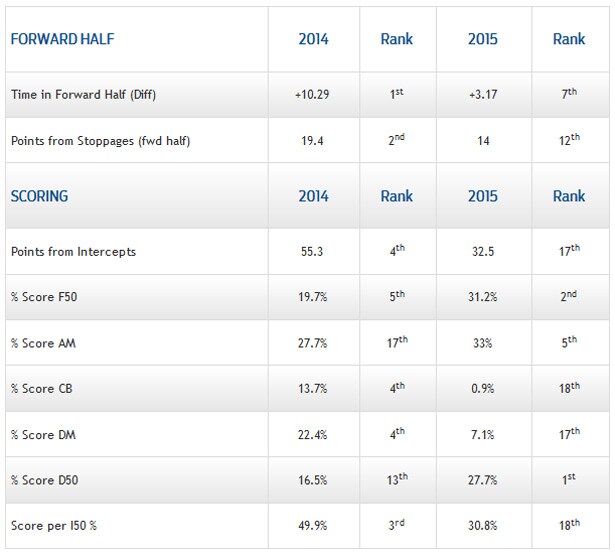
Last week, Sydney delivered a master class on how to combat Port Adelaide’s equal round-high 62 inside 50s. The Swans defensive machine was at its best continually swarming in numbers and clogging space. When the turnover came the Swans would transition at speed to make the most of an isolated forward line. What really set Sydney up though was their work at stoppages, an area where they really put the clamps on the Power.
North Melbourne has to replicate the Swans mindset this Saturday night. Win the fight at the coalface and you’re free to make it ugly everywhere else. As Sydney discovered, the opportunities in transition will come if the defence is stout. North scored from a round-high 46.2 per cent of chains in their defensive half against Brisbane, showcasing a run and carry brand of footy that’s capable of splitting open any side.
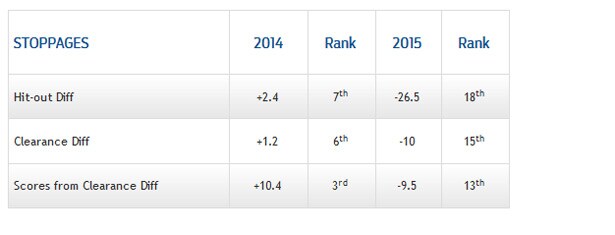
Congestion a key
A Port Adelaide outfit averaging the fewest points per game after facing the two best defences in the competition shouldn’t be too surprising.
What should surprise is the more controlled tempo we’ve seen from the Power so far. There’s a distinct difference in their usual manic ball movement that we’ve come so accustomed to. Playing at unrelenting pace is what set Port apart and made them so tough to beat.
Some of the Port Adelaide traits we know remain; they still play on more than any other side but it’s the short, backwards and sideways calculated attack by foot that’s foreign. They currently lead the competition in uncontested marks and uncontested possessions – two areas that weren’t a hallmark of how they operated a season ago.
There’s far more ball use backwards of centre with the Power accumulating the seventh most defensive 50 chains. It’s a far cry from the fast ball movement and transition speed we saw in 2014 which produced the fifth most points in transition and second most points overall.
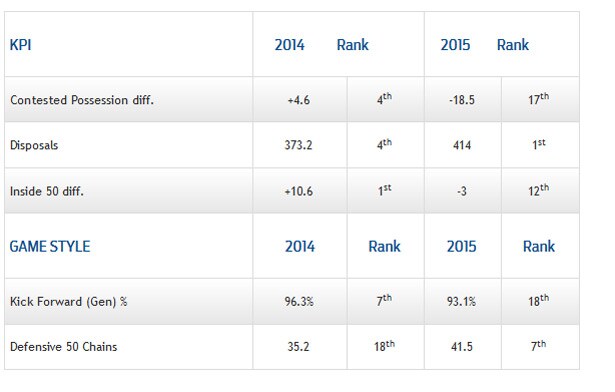
Given they’ve faced Fremantle and Sydney, there’s arguably no worse opening set of fixtures for Port to put a tweaked game plan into practice against, so panic isn’t warranted just yet. As it stands, the end result has been a Power outfit that sits dead last for goal scoring efficiency and 14th for points off turnover differential.
Opponents are experiencing far too much time to set up defensively due to the Power’s apparent desire for more control, and at the same time teams are hurting them on the counter.
Sydney impressed by exiting the ball with poise via the least risky option. In 2014, Port defended exit lanes via the corridor at the second best rate of any side continually producing repeat entries from panic exit kicks. Settling for a stoppage reset boundary side out of Port’s attacking zone is a welcomed result and it’s what the Swans continually looked for.
With the current form of Todd Goldstein and weakened Port Adelaide ruck stocks, the more stoppages around the ground the healthier North Melbourne’s prospects.
The three-pronged attack
The importance of the Kangaroos three key forward set-up will be critical against Port Adelaide. Against Sydney, the Power played Tom Jonas as a loose man in defence with Dane Rampe loose for the Swans. The idea for Port was to try and limit the space for Franklin and Tippett, and the Swans adjusted by utilising either forward higher up the ground, something Ben Brown or Drew Petrie has the athleticism to emulate.
With possession we saw the Swans break at pace to reduce the impact of any forward line congestion – the opposite of what we saw from Port Adelaide. Forwards like Waite and Petrie need space to lead into and the quicker the entries the lesser the impact of a loose if Port do opt for it.
In the following example, Lance Franklin wins the footy after attracting all the attention and hands off to Isaac Heeney who has Tippett one out in prime position. If either Brown or Petrie can lead their opponent to the footy and win enough ball, it will only increase the effectiveness of North’s forwards who should thrive with so much space to work with.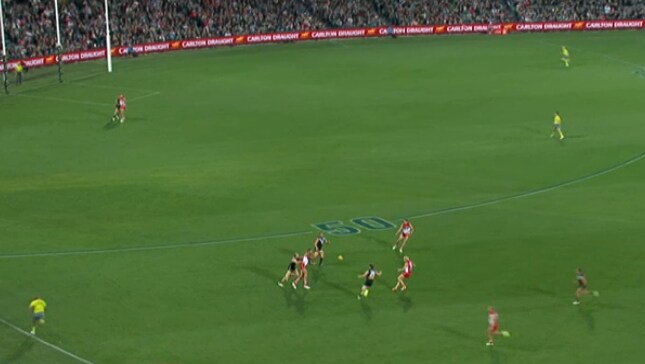
Such a set-up would suit the Kangaroos because they know how to score efficiently due to their heavy dependence on the corridor and ability to isolate key position targets forward of centre. In 2014, North Melbourne and Fremantle were the only sides to target the corridor more than 50 per cent of occasions when venturing inside 50 by foot, well above the league average of 39.21 per cent. By comparison, Port Adelaide focused on the corridor the least of any side with just 30.99 per cent of entries by foot aimed at the corridor.
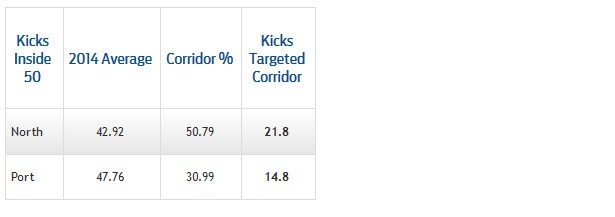
Things haven’t changed so far in 2015. Of North Melbourne’s 105 forward 50 entries a league-high 49.5 per cent have been directed at the corridor compared to Port Adelaide’s 104 entries at 26.9 per cent.
The key is forcing Port Adelaide to the flanks where the likes of Wingard, Gray and Westhoff convert shots at goal from an angle at 33.3, 36.4 and 26.7 per cent. Last year the Power produced 71 more shots from an angle than any other side at the second worst accuracy compared to the corridor where they were the third most accurate outfit.
Sides like North Melbourne would prefer to work the ball backwards or laterally to find a more central avenue to goal, Port Adelaide is happy to settle for the first opening which isn’t always the most lucrative. Only the Gold Coast Suns utilise more one disposal chains in their attacking midfield than the Power, which highlights their desire to continually utilise the first option they see inside 50.
Kane Cornes displayed Port Adelaide’s tendency to embrace the flanks against Sydney in the following example, although he wasn’t alone in this mindset. After winning the ball in the corridor, Cornes wheels around and should run at his Sydney opponent. From here, acres of space open up for his running mate with simple handball overlap on offer, but instead Cornes ignores that option and pushes the ball wide inside 50 where the Swans have a two-on-one advantage and force a turnover.
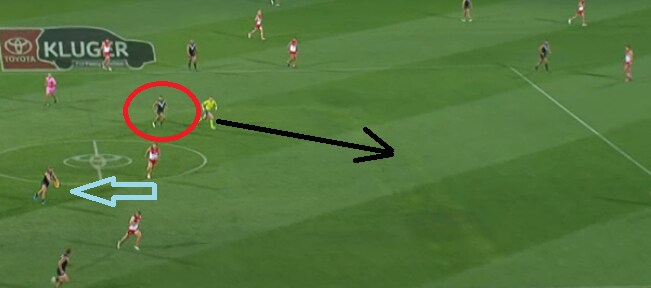
There’s no doubt the Swans did their homework when positioning an extra number in defence and it’s an area where North can gain a significant advantage.
Here Robbie Gray is in similar circumstance. Port Adelaide has the numbers and several options on offer to straighten up and attack from a more central avenue. Instead, Gray opts for the red circle option and Sydney uses their two-on-one advantage to kill the play. When Port and North met last year, Thompson, Grima, Hansen, Atley and Cunnington combined for 31 intercept possessions. Replicate that output and North is in the box seat for four points.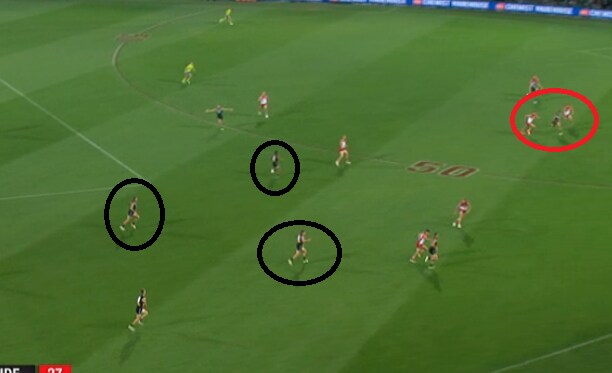
Who will win and why?
Dominating stoppages, creating congestion in defensive 50 and isolating key forward targets were the backbones of the Swans victory against the Power.
North Melbourne has the capability to deliver a similar output from a structural, work rate and discipline perspective.
The biggest challenge will fall on the Kangaroos midfield and their ability to work back defensively to create hesitation in Port’s decision-making and limit space for Port Adelaide’s forwards which was something both the Swans and Dockers did so well. With the goal scoring talent of Wingard, Gray, Monfries, Hartlett, White and Boak frequently lurking, no side is more dangerous in their forward 50 at ground level.
Todd Goldstein will be delivering more than enough opportunity for the Roos to press an advantage at stoppages where the Power have been so lacklustre to date, and North Melbourne’s key position targets up forward possess the athleticism and around the ground ability to really stretch out the Port Adelaide defence.
Tip: North Melbourne by 10 points



